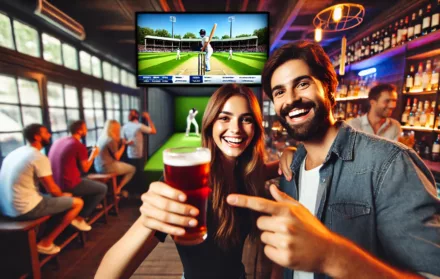
How to Handle Alcohol at Hen Dos
Navigating the effervescent waters of celebration, particularly when it comes to orchestrating a hen do, often brings us face to face with a myriad of considerations, one of the most pivotal is how to handle alcohol at hen dos.
The bubbling champagne, the clinking of glasses, and the light-hearted toasts are often synonymous with these pre-wedding celebrations, weaving a tapestry that’s as vibrant and varied as the attendees themselves.
Managing the presence, consumption, and effects of alcohol, thereby, becomes an art, where the brush strokes must carefully balance enjoyment with responsibility, ensuring every memory crafted is cherished and every experience, positive.
The delicate dance with spirits, wines, and brews at such gatherings is more than just about selecting the finest bottle of champagne or crafting the most exquisite cocktail.
It’s about creating an environment where enjoyment is not just encouraged but also safely managed, ensuring that every toast raised is a moment of shared joy and every sip taken is in the spirit of collective celebration.
The role of alcohol at hen dos, while often seen as a catalyst for fun and revelry, also comes with its own set of responsibilities and considerations, each as crucial as the other in ensuring the safety, comfort, and enjoyment of all attendees.
In the realm of hen dos, where emotions, excitement, and expectations intertwine, managing alcohol is not merely about controlling its consumption but understanding its impact on the dynamics of the event.
It’s about ensuring that every attendee, whether they choose to indulge in a glass of wine or prefer a non-alcoholic alternative, feels included, respected, and valued. It’s about recognizing that every individual has their own unique relationship with alcohol and ensuring that the environment is conducive to respecting and honoring these individual preferences.
As we delve deeper into the intricacies of managing alcohol at hen dos, we will explore the various facets that come into play, from selecting the right beverages and ensuring responsible consumption to creating an inclusive environment that honors the choices of all attendees.
It’s a journey that will take us through the vibrant lanes of celebration, exploring ways to ensure that every moment is not only memorable but also safely enjoyed.
Join us, as we explore the multifaceted world of hen dos, unraveling the threads that will help us weave a celebration that is as safe as it is joyous, ensuring every cheer is heartfelt and every memory, cherished.
Setting Alcohol Limits
Setting alcohol limits is crucial for a safe and enjoyable experience at hen parties. Please follow these steps to effectively manage alcohol consumption:
1. Educate: Inform guests about the importance of setting alcohol limits and the risks of excessive drinking. Emphasise the need for responsible drinking and watching out for one another.
2. Plan: Establish a limit on the number of alcoholic drinks per person. This helps prevent excessive drinking and ensures that everyone stays within a safe range. Take into account factors such as the duration of the event, availability of non-alcoholic options, and individual tolerance levels.
3. Monitor: Keep track of each person’s drink count. Appoint someone to monitor and discreetly intervene if necessary, ensuring that the set alcohol limits are adhered to.
4. Offer alternatives: Provide a variety of non-alcoholic beverages as options. This can include mocktails, infused water, or soft drinks. Having appealing non-alcoholic choices encourages moderation.
5. Create a supportive environment: Foster a comfortable atmosphere where people feel comfortable declining more drinks or stopping when they have reached their alcohol limit. Encourage open communication and respect individual choices regarding alcohol.
By following these steps, you can effectively establish alcohol limits at hen parties. Remember, the focus is on creating a fun and safe environment for everyone involved. Enjoy the celebrations responsibly!
Providing Non-Alcoholic Alternatives
Providing non-alcoholic alternatives is crucial for inclusive and enjoyable hen parties. Here are some options to consider:
Mocktails: Create a menu of delicious mocktails using fresh fruits, juices, and herbal infusions. Non-drinkers can still enjoy sophisticated and tasty drinks.
Virgin versions: Offer non-alcoholic versions of popular cocktails like mojitos, margaritas, and martinis. Use sparkling water, fruit syrups, and crushed herbs.
Social sippers: Provide non-alcoholic beers, ciders, and wines for those who prefer the taste of traditional alcoholic beverages without the alcohol content. Many brands produce high-quality options that replicate the experience without the negative effects of alcohol.
Hydration station: Set up a hydration station with infused water or flavored sparkling water. This offers a refreshing and healthy alternative to alcohol, especially during hot days or outdoor activities.
Non-alcoholic shots: Serve creative and exciting non-alcoholic shots made with juices, syrups, and garnishes. Enjoy them as a fun and interactive experience during the celebrations.
Pro-tip: When offering non-alcoholic alternatives, make them visually appealing and well-presented like alcoholic beverages. Garnishes, colourful straws, and fancy glassware will make non-drinkers feel included and ensure they have a remarkable experience.
Encouraging Responsible Drinking
Encouraging responsible drinking is essential for alcohol consumption at hen dos. You can create a safe and enjoyable environment by implementing the following practices:
Offer non-alcoholic alternatives: Provide mocktails, fruit juices, and infused water, giving everyone a choice and allowing them to participate without feeling excluded.
Set limits: Establish guidelines for alcohol consumption. Encourage guests to drink responsibly and pace themselves. This can be done through a limited open bar or a maximum number of drinks per person.
Provide food: Serve a variety of snacks and appetizers to slow down alcohol consumption and prevent drinking on an empty stomach.
Offer transportation options: Arrange for taxis, ride-sharing services, or designated drivers to ensure everyone’s safety getting home.
Encourage hydration: Promote water consumption by making water readily available and reminding guests to stay hydrated.
In a similar situation, a group of friends organized a bachelorette party and followed these responsible drinking practices. They provided non-alcoholic options, set a limit of two alcoholic drinks per person, served finger food, arranged for a shuttle service, and encouraged guests to drink water between alcoholic beverages. As a result, everyone had a fantastic time while looking after each other’s well-being.
Ensuring Safe Transportation
When it comes to ensuring safe transportation at hen parties, there are important steps to consider:
1. Employ a reputable transportation service. Select a reliable company with a strong track record and positive customer reviews. This will guarantee the safety of everyone involved.
2. Plan routes in advance. Take into account the locations the group will be travelling to and from. This will prevent any confusion and ensure smooth transportation.
3. Arrange designated drivers. Assign responsible drivers who will abstain from consuming alcohol. This ensures that there is always a responsible individual behind the wheel.
4. Promote the use of public transportation. Suggest buses or trains for group travel, eliminating the need for designated drivers.
5. Provide information about local taxi services. Share details about local taxi services for individual or separate travel.
6. Remind everyone to drink responsibly. While transportation arrangements are important, it is equally important to encourage moderation and responsible drinking.
By following these steps, you can ensure safe transportation at the hen party and ensure that everyone can enjoy the celebration responsibly.
Organizing Activities that Don’t Focus on Alcohol
Organizing activities that don’t focus on alcohol is important for an inclusive and enjoyable hen do. Here are some ideas:
Outdoor Adventures: Plan activities like hiking, canoeing, or cycling. These not only provide exercise but also foster bonding and create lasting memories.
Creative Workshops: Arrange pottery painting, candle making, or floral arranging. These activities encourage artistic expression and relaxation.
Wellness Retreats: Explore options like yoga retreats, spa days, or meditation sessions. These promote relaxation, mindfulness, and self-care.
Games and Challenges: Arrange fun activities like treasure hunts, escape rooms, or team-building challenges. These foster teamwork, problem-solving, and friendly competition.
Food and Cooking Workshops: Participate in cooking classes, food tours, or wine tastings (non-alcoholic options available). These allow participants to learn culinary skills and enjoy delicious food.
Cultural Experiences: Visit museums, art galleries, historical sites, or attend theater performances. These provide opportunities to explore and appreciate art, history, and culture.
Charity Work: Consider volunteering at a local charity or organizing a fundraising event. This promotes giving back and making a positive impact in the community.
Remember to communicate with the group to understand their preferences, limitations, and comfort levels. You can mix and match these activities based on the interests and preferences of the attendees while ensuring everyone feels included and engaged throughout the celebrations.
Managing Peer Pressure
Managing Peer Pressure is crucial for handling alcohol at Hen Dos. Here are strategies to effectively manage peer pressure:
- Communicate assertively: Clearly express your decisions and boundaries about alcohol. Use “I” statements to convey your preferences and values.
- Surround yourself with supportive friends: Choose friends who respect your choices and values. A strong support network can help resist peer pressure.
- Stay true to your goals: Prioritize your well-being and stick to your personal goals. Remember why you may choose to limit or avoid alcohol.
- Suggest alternative activities: Encourage non-alcoholic group activities like games, dancing, or local exploration. This can shift the focus away from drinking and create a fun and inclusive atmosphere.
- Educate yourself: Learn about the risks and consequences of excessive alcohol consumption. Understanding the effects of alcohol can empower informed decision-making.
- Practice refusal skills: Role-play scenarios where alcohol is offered and practice confidently saying “no“. This can build confidence in resisting peer pressure.
- Have a plan: If you choose to drink, set limits and stick to them. Pace yourself, alternate between alcoholic and non-alcoholic drinks, and always have a safe way to get home.
Remember, prioritize your own well-being and make decisions aligned with your values and goals.
Creating a Supportive Environment
Creating a supportive environment at a hen do is crucial for the comfort and inclusion of everyone. Here are some suggestions to achieve this:
1. Foster open communication: Encourage everyone to express their needs, boundaries, and alcohol preferences. This promotes respect and understanding.
2. Provide non-alcoholic options: Offer attractive non-alcoholic drinks such as mocktails, fruit-infused water, or alcohol-free beverages for those who do not wish to consume alcohol.
3. Plan inclusive activities: Organize activities that do not solely focus on drinking. These could include spa days, outdoor adventures, or creative workshops. Offering a variety of options ensures that everyone can participate and have a pleasant time.
4. Be mindful of individual limits: Remind everyone to drink responsibly and be aware of their own alcohol tolerance. Create an environment where people feel comfortable declining additional drinks if they have reached their limit.
5. Support those who choose not to drink: Accept and understand those who choose not to consume alcohol. Do not pressure or question their decision and provide access to non-alcoholic options.
Remember, creating a supportive environment is essential for a positive hen do experience. By considering the needs of all participants, you can promote inclusivity and enjoyment for everyone involved.
Addressing Alcohol-Related Issues
To ensure a safe and enjoyable experience for everyone involved in a hen do or any event with alcohol, it is important to address potential alcohol-related issues. Consider the following key points:
1. Set clear limits: Establish a maximum number of drinks or a specific drinking timeframe to prevent excessive alcohol consumption and associated risks.
2. Provide alternatives: Cater to non-drinkers by offering a variety of non-alcoholic options such as mocktails, soft drinks, and infused water.
3. Encourage responsible drinking: Promote moderation and hydration throughout the event. Remind guests to pace themselves and avoid drinking on an empty stomach.
4. Offer transportation options: Arrange safe transportation to and from the venue, such as hiring a minibus or providing information about local taxis or ride-sharing services.
5. Be vigilant: Watch for signs of intoxication or discomfort among guests. Encourage breaks, non-alcoholic drinks, or seeking assistance if needed.
During a friend’s hen do, we implemented these measures. We set a limit of three drinks per hour and provided a range of non-alcoholic options, including a mocktail bar. We encouraged responsible drinking and reminded everyone to stay hydrated. For safety, we arranged a minibus for transportation. Throughout the evening, we kept a watchful eye on our friends, offering breaks and support if anyone felt unwell. The result was a memorable and enjoyable experience for all, with everyone feeling safe and cared for.
By addressing alcohol-related issues responsibly and proactively, you can create an enjoyable atmosphere while ensuring the well-being of your guests.
Communicating with Participants and Venue
When organizing a hen do and handling alcohol, it is essential to have effective communication with participants and the venue. Here are some key points to bear in mind:
The first step is to inform participants clearly about the important event details, including the date, time, and location. It is also crucial to provide information about any specific alcohol-related activities or themes.
Another important aspect is to take into account the dietary preferences of the participants. Inquire about any dietary restrictions or preferences, including their alcohol preferences.
It is important to ensure that the chosen venue has the capacity to accommodate the number of participants. It is recommended to inform the venue about the expected number of attendees.
In terms of licensing and regulations, it is essential to verify if the venue possesses the necessary licenses to serve alcohol and comply with local regulations. It is also important to communicate any specific requests or requirements.
Discussing transportation arrangements with the venue is crucial, particularly if alcohol will be consumed. It is important to ensure that safe transportation options, such as taxis or ride-sharing services, are available.
Remember, clear communication with participants and the venue is vital to guarantee a successful and enjoyable hen do. It is recommended to discuss expectations, preferences, and necessary arrangements in order to ensure the safety and comfort of everyone involved.
10 Tips for a Fun and Safe Alcohol-Friendly Hen Do
Planning a hen party can be exciting, but it is essential to ensure that everyone has an enjoyable and safe time, especially when alcohol is involved. Here are ten tips for a fun and safe alcohol-friendly hen do:
- Establish a limit: Come to an agreement on a reasonable amount of alcohol to be consumed during the hen party and ensure that everyone is aware.
- Offer alternatives: Provide non-alcoholic options for those who choose not to drink alcohol, such as mocktails, fruit punches, and infused water.
- Designate a driver: If you are going out, make sure there is a designated driver or a transportation plan in place to ensure everyone’s safety.
- Promote hydration: Remind everyone to drink water between alcoholic beverages to stay hydrated.
- Take breaks: Include alcohol-free activities in the itinerary, like a spa day or a hike, to give everyone an opportunity to relax and recharge.
- Know your limits: Ensure that everyone is aware of their personal alcohol limits and promote responsible drinking.
- Support each other: Look out for one another and intervene if someone shows signs of intoxication or needs assistance.
- Plan food options: Make sure there is plenty of food available throughout the hen party to absorb alcohol and keep everyone energized.
- Have a contingency plan: If someone needs to leave early or take a break, have a backup plan in place to ensure their safety.
- Communication is vital: Maintain open communication with all participants of the hen party and address any concerns or restrictions regarding alcohol in advance.
What Are the Legal Drinking Ages in the UK?
When it comes to the legal drinking ages in the UK, it is important to be aware of the regulations in place for responsible consumption. So, what are the legal drinking ages in the UK? In England, Wales, and Northern Ireland, the legal drinking age is 18 years old. The same applies to Scotland where the legal drinking age is also 18 years old.
These legal drinking ages protect young individuals from the potential risks and harms associated with alcohol consumption at a young age. It is crucial to abide by these laws and encourage responsible drinking.
Reflecting on the impact of alcohol, I recall an incident where underage individuals defied the legal drinking age and engaged in excessive alcohol consumption, resulting in one person being hospitalized due to alcohol poisoning.
This incident serves as a lesson on the importance of respecting and adhering to the legal drinking ages. It highlights the potential dangers of excessive alcohol consumption, especially when underage.
By understanding and abiding by the legal drinking ages in the UK, we can create a safer and healthier environment for responsible alcohol consumption and avoid the negative consequences of underage drinking.
How to Handle Alcohol at Hen Dos: Dangers of Excessive Alcohol Consumption
Excessive alcohol consumption can have serious implications for both our physical and mental well-being. It poses numerous dangers, including the risk of developing significant medical conditions such as liver disease, heart problems, digestive disorders, and even certain types of cancer.
It impairs our ability to make sound judgments, leading to risky behavior and potential hazards. Regular and excessive alcohol intake can result in alcohol use disorder, a chronic condition characterized by an inability to control or halt drinking despite negative consequences.
Alcohol adversely affects our coordination, reaction time, and cognitive function, greatly increasing the likelihood of accidents, falls, and injuries. It can strain personal relationships, contribute to mental health issues, negatively impact our professional and educational endeavors, create financial hardships, and even lead to legal ramifications like fines, imprisonment, and a criminal record.
Engaging in excessive alcohol consumption is strongly associated with a heightened risk of domestic violence, assault, and various other forms of violent behavior. Therefore, it remains crucial to consume alcohol responsibly and prioritize our overall health and well-being.
In light of this, it is important to note that alcohol’s detrimental effects extend far beyond our personal lives. According to the World Health Organization, alcohol is responsible for a staggering 3 million deaths annually worldwide, accounting for 5.3% of all deaths.
These statistics emphasize the urgency of actively addressing the dangers associated with excessive alcohol consumption. By recognizing the risks and making informed decisions, we can strive to lead healthier and safer lives.
How Can Alcohol Impact Relationships?

Alcohol can have a significant impact on relationships. It is important to be aware of how alcohol can impact relationships these effects in order to maintain healthy connections with others.
1. Consuming excessive amounts of alcohol can cause emotional turbulence in relationships. It can lead to heightened emotions, mood swings, and aggression, which strain relationships and cause conflicts.
2. Alcohol abuse often leads to breakdowns in communication. It impairs judgment and decision-making abilities, making it difficult to effectively express thoughts and feelings. This can result in misunderstandings and increased tension in relationships.
3. Alcohol can erode trust. It lowers inhibitions and impairs judgment, leading to regrettable behaviours such as infidelity and broken promises. This damages trust within relationships.
4. Alcohol addiction strains relationships. When one partner struggles with alcohol dependency, the dynamics of the relationship become imbalanced and unhealthy. The non-addicted partner may feel frustrated, angry, and helpless, further straining the relationship.
5. Excessive alcohol consumption can lead to financial issues. The costs of purchasing alcohol put a strain on a couple’s finances, and the consequences of alcohol-related incidents (such as legal fees or medical expenses) create additional financial stress.
To maintain healthy relationships, it is important to be mindful of the impact of alcohol. Open and honest communication, setting boundaries, and seeking support are crucial steps in managing the effects of alcohol on relationships. Understanding these impacts allows individuals to make informed choices that protect and nurture their relationships.
What Are the Signs of Alcohol Addiction?
Alcohol addiction is a serious condition that can have significant effects on physical and mental health. It is important to be aware of the signs of alcohol addiction so that appropriate support and intervention can be provided.
1. Increased tolerance: One sign of alcohol addiction is developing a higher tolerance. This means needing to drink larger amounts to achieve the desired effect.
2. Withdrawal symptoms: When addicted to alcohol, individuals may experience withdrawal symptoms when trying to stop or cut back. Symptoms can include tremors, nausea, anxiety, and insomnia.
3. Loss of control: Another sign of alcohol addiction is the inability to control or limit drinking. Cutting back or stopping may be difficult or impossible.
4. Neglecting responsibilities: People with alcohol addiction often prioritize drinking over work, school, or family obligations. They may neglect important tasks or struggle to fulfill duties due to their drinking.
5. Continued use despite negative consequences: Even when faced with relationship problems, health issues, or legal troubles, individuals struggling with alcohol addiction will continue to drink.
6. Spending significant time obtaining and using alcohol: People with alcohol addiction may invest much time and effort in obtaining and consuming alcohol, often at the expense of other activities or hobbies.
7. Loss of interest in other activities: Individuals with alcohol addiction may lose interest in activities they once enjoyed and instead prioritize drinking.
It is important to remember that alcohol addiction is a treatable condition, and support is available. If you or someone you know is showing signs of alcohol addiction, seek help from healthcare professionals or support groups. Remember, reaching out and asking for help is the first step towards recovery.
As a related fact, the National Institute on Alcohol Abuse and Alcoholism states that over 15 million adults in the United States have alcohol use disorder. Approximately 88,000 people die from alcohol-related causes annually.
Can Hen Dos Be Enjoyed without Alcohol?
Hen dos can absolutely be enjoyed without alcohol. Consider these creative ideas:
- Plan alternative activities: Organize activities that cater to different interests and preferences, such as spa days, outdoor adventures, or creative workshops. This way, everyone can participate and have a great time.
- Serve delicious mocktails: Create non-alcoholic cocktails that are just as flavorsome and refreshing as their alcoholic counterparts. This way, everyone can enjoy a fancy drink without the alcohol.
- Embrace the party atmosphere: Create a lively and festive atmosphere with decorations, music, and entertainment that doesn’t center around alcohol. This will help set the mood and ensure everyone has a great time.
- Offer a variety of drinks: Provide non-alcoholic options, soft drinks, juices, flavored water, and herbal teas. This caters to everyone’s preferences and ensures nobody feels left out.
- Encourage socializing and bonding: Plan activities and games that promote socializing and bonding, such as icebreaker games, team-building activities, or group challenges. This allows everyone to connect and enjoy each other’s company.
- Provide support and understanding: Create a supportive environment for guests who choose to drink alcohol. Encourage responsible drinking and ensure non-drinkers feel included and not pressured.
Remember, the key to enjoying a hen do without alcohol is to create a memorable and inclusive experience for all participants. Offering alternative options, embracing a lively atmosphere, and prioritizing socializing and fun activities will ensure everyone has a fantastic time, regardless of their choice to drink alcohol or not.





